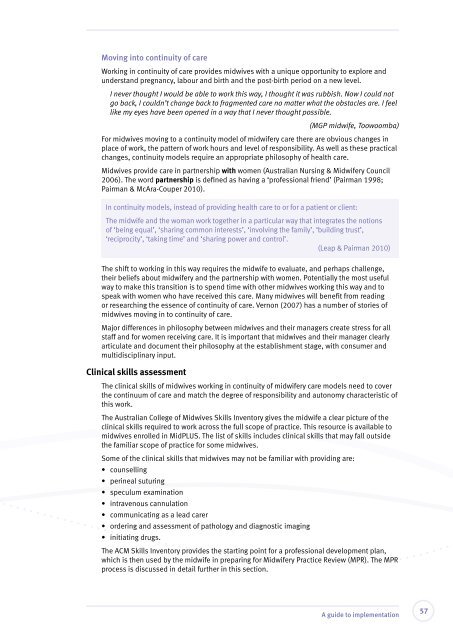Delivering continuity of midwifery care to Queensland women
Delivering continuity of midwifery care to Queensland women
Delivering continuity of midwifery care to Queensland women
You also want an ePaper? Increase the reach of your titles
YUMPU automatically turns print PDFs into web optimized ePapers that Google loves.
Moving in<strong>to</strong> <strong>continuity</strong> <strong>of</strong> <strong>care</strong><br />
Working in <strong>continuity</strong> <strong>of</strong> <strong>care</strong> provides midwives with a unique opportunity <strong>to</strong> explore and<br />
understand pregnancy, labour and birth and the post-birth period on a new level.<br />
I never thought I would be able <strong>to</strong> work this way, I thought it was rubbish. Now I could not<br />
go back, I couldn’t change back <strong>to</strong> fragmented <strong>care</strong> no matter what the obstacles are. I feel<br />
like my eyes have been opened in a way that I never thought possible.<br />
(MGP midwife, Toowoomba)<br />
For midwives moving <strong>to</strong> a <strong>continuity</strong> model <strong>of</strong> <strong>midwifery</strong> <strong>care</strong> there are obvious changes in<br />
place <strong>of</strong> work, the pattern <strong>of</strong> work hours and level <strong>of</strong> responsibility. As well as these practical<br />
changes, <strong>continuity</strong> models require an appropriate philosophy <strong>of</strong> health <strong>care</strong>.<br />
Midwives provide <strong>care</strong> in partnership with <strong>women</strong> (Australian Nursing & Midwifery Council<br />
2006). The word partnership is defined as having a ‘pr<strong>of</strong>essional friend’ (Pairman 1998;<br />
Pairman & McAra-Couper 2010).<br />
In <strong>continuity</strong> models, instead <strong>of</strong> providing health <strong>care</strong> <strong>to</strong> or for a patient or client:<br />
The midwife and the woman work <strong>to</strong>gether in a particular way that integrates the notions<br />
<strong>of</strong> ‘being equal’, ‘sharing common interests’, ‘involving the family’, ‘building trust’,<br />
‘reciprocity’, ‘taking time’ and ‘sharing power and control’.<br />
(Leap & Pairman 2010)<br />
The shift <strong>to</strong> working in this way requires the midwife <strong>to</strong> evaluate, and perhaps challenge,<br />
their beliefs about <strong>midwifery</strong> and the partnership with <strong>women</strong>. Potentially the most useful<br />
way <strong>to</strong> make this transition is <strong>to</strong> spend time with other midwives working this way and <strong>to</strong><br />
speak with <strong>women</strong> who have received this <strong>care</strong>. Many midwives will benefit from reading<br />
or researching the essence <strong>of</strong> <strong>continuity</strong> <strong>of</strong> <strong>care</strong>. Vernon (2007) has a number <strong>of</strong> s<strong>to</strong>ries <strong>of</strong><br />
midwives moving in <strong>to</strong> <strong>continuity</strong> <strong>of</strong> <strong>care</strong>.<br />
Major differences in philosophy between midwives and their managers create stress for all<br />
staff and for <strong>women</strong> receiving <strong>care</strong>. It is important that midwives and their manager clearly<br />
articulate and document their philosophy at the establishment stage, with consumer and<br />
multidisciplinary input.<br />
Clinical skills assessment<br />
The clinical skills <strong>of</strong> midwives working in <strong>continuity</strong> <strong>of</strong> <strong>midwifery</strong> <strong>care</strong> models need <strong>to</strong> cover<br />
the continuum <strong>of</strong> <strong>care</strong> and match the degree <strong>of</strong> responsibility and au<strong>to</strong>nomy characteristic <strong>of</strong><br />
this work.<br />
The Australian College <strong>of</strong> Midwives Skills Inven<strong>to</strong>ry gives the midwife a clear picture <strong>of</strong> the<br />
clinical skills required <strong>to</strong> work across the full scope <strong>of</strong> practice. This resource is available <strong>to</strong><br />
midwives enrolled in MidPLUS. The list <strong>of</strong> skills includes clinical skills that may fall outside<br />
the familiar scope <strong>of</strong> practice for some midwives.<br />
Some <strong>of</strong> the clinical skills that midwives may not be familiar with providing are:<br />
• counselling<br />
• perineal suturing<br />
• speculum examination<br />
• intravenous cannulation<br />
• communicating as a lead <strong>care</strong>r<br />
• ordering and assessment <strong>of</strong> pathology and diagnostic imaging<br />
• initiating drugs.<br />
The ACM Skills Inven<strong>to</strong>ry provides the starting point for a pr<strong>of</strong>essional development plan,<br />
which is then used by the midwife in preparing for Midwifery Practice Review (MPR). The MPR<br />
process is discussed in detail further in this section.<br />
A guide <strong>to</strong> implementation<br />
57
















